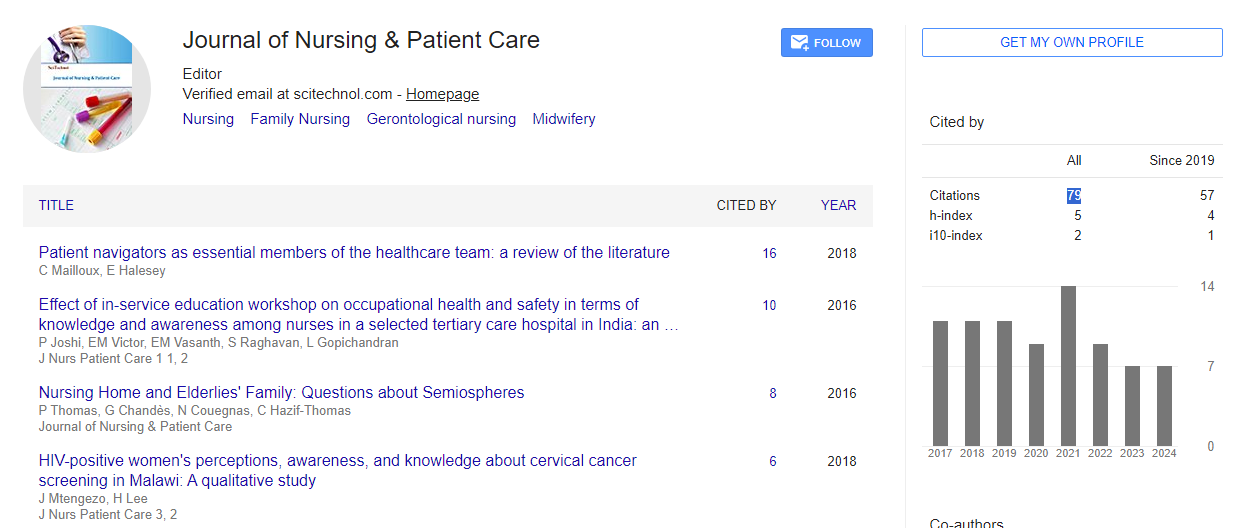The effectiveness of education strategies to the health care professions on using physical restraint: an evidence-based practice review
AMF Ng, TY Lam, YW Ho, HY Hui and SM Kwan
Caritas Institute of Higher Education, Hong Kong
: J Nurs Patient Care
Abstract
The use of physical restraint is high in prevalence and it is being an important issue in hospital care in Hong Kong. Using of physical restraint is controversial in the past decades owing to the concern on extensive or misuse in daily patient care. Nurses’ perception and knowledge on using the physical restraint play a pivotal role on care decision. In view of this, scholarly works had shed light on educational approach to the health care profession on the way of using physical restraint. Research evidence has now been suggested that educational strategies in different approach are beneficial to enhance health care professions’ knowledge and practice in using physical restraint. Besides, different levels of evidence significantly shown that there are positive impacts in terms of fall reduction, shift of application mode, increase use of alternatives, practical skills enhancement, and reduce prevalence of restraint-associated injuries. This paper aimed at exploring the best available research evidence regarding the educational strategies to the health care profession on using physical restraint. The selected evidence are critically appraise that follow by the justification for clinical change. Further, recommendations to develop the best evidence-based practice on educate health care profession on using physical restraint are suggested. The possible outcome indicators of the educational strategies including the aspect of knowledge, attitude and practice of the health care profession are discussed. The nursing implication of the proposed practice change can improve patients’ quality of life during hospitalization as well as promoting continuing nursing education in patient care. References: 1. Huang, H. T., Chuang, Y. H., & Chiang, K. F. (2009). Nurses’ physical restraint knowledge, attitudes, and practices: The effectiveness of an in-service education program. Journal of Nursing Research, 17(4), 241-248. 2. Lai, C. K., Chow, S. K., Suen, L. K., & Wong, I. Y. (2011). The effect of a restraint reduction program on physical restraint rates in rehabilitation settings in Hong Kong. Rehabilitation Research and Practice, 2011. 3. Martin, A., Krieg, H., Esposito, F., Stubbe, D., & Cardona, L. (2008). Reduction of restraint and seclusion through collaborative problem solving: A five-year prospective inpatient study. Psychiatric Services, 59(12), 1406-1412. 4. Nasrate, H., Shamlawi, A., & Darawad, M. W. (2017). Improving ICU nurses’ practices of physical restraints in Jordan: Effect of an educational program. Health, 9(12), 1632-1643. 5. Omolewa, P. (2012). The impact of instructive educational program on physical restraint reduction in acute mental health hospitals. Walden University.
Biography
AMF Ng. Caritas Institute of Higher Education, Hong Kong. She is Assistant Professor of the School of Health Sciences, Caritas Institute of Higher Education, Hong Kong. TY Lam, YW Ho, HY Hui and SM Kwan. Caritas Institute of Higher Education, Hong Kong. Undergraduate students, Bachelor of Nursing, School of Health Sciences, Caritas Institute of Higher Education, Hong Kong. mfng@cihe.edu.hk
 Spanish
Spanish  Chinese
Chinese  Russian
Russian  German
German  French
French  Japanese
Japanese  Portuguese
Portuguese  Hindi
Hindi 